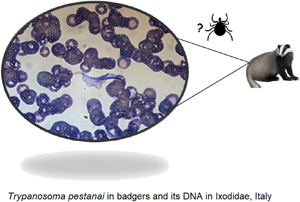Article contents
Trypanosoma (Megatrypanum) pestanai in Eurasian badgers (Meles meles) and Ixodidae ticks, Italy
Published online by Cambridge University Press: 05 July 2021
Abstract

Trypanosomes are haemoflagellate protozoa transmitted by blood-feeding arthropods causing infections in a wide range of mammals, including humans. Adult badgers (Meles meles, n = 2), displaying severe paralysis, ataxia and severe ectoparasite infestation, were rescued from a peri-urban area of Bari (southern Italy). Blood samples and ectoparasites were screened for Trypanosoma spp. by the combined PCR/sequencing approach, targeting a fragment of 18S rRNA gene. Smears of haemolymph, guts and salivary glands of the alive ticks were microscopically observed. No haematological alterations, except thrombocytopenia, were found. Trypomastigotes and epimastigotes were observed in the blood smears of both badgers and Trypanosoma pestanai was molecularly identified. Out of 33 ticks (i.e. n = 31 Ixodes canisuga, n = 2 Ixodes ricinus) and two fleas (Ctenocephalides felis), 11 specimens (n = 5 I. canisuga engorged nymphs, n = 4 engorged females and n = 2 I. ricinus engorged females) tested positive only for T. pestanai DNA. All smears from ticks were negative. The present study firstly revealed T. pestanai in Ixodidae and badgers from Italy, demonstrating the occurrence of the protozoan on the peninsula. Further studies are needed to clarify the occurrence of the only known vector of this parasite, Paraceras melis flea, as well as other putative arthropods involved in the transmission of T. pestanai.
- Type
- Research Article
- Information
- Copyright
- Copyright © The Author(s), 2021. Published by Cambridge University Press
References
- 4
- Cited by





